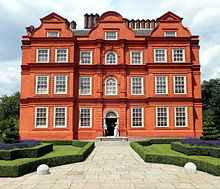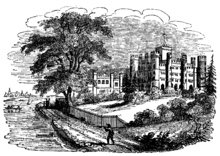Kew Palace
Kew Palace is a royal palace of the United Kingdom in the Royal Botanical Gardens at Kew on the banks of the Thames above London . There were at least three palaces in Kew over time and two of them were called "Kew Palace". The first such building was probably not called that; the only record of it is the words of a courtier. The second palace still exists today, was listed by English Heritage as a Grade I Historic Building and is open to the public. The palace is owned by an independent, non-profit organization, Historic Royal Palaces, which does not receive any subsidies from the state or the royal family.
The first Kew Palace
Little is known about this building, except that Queen Elizabeth I gave it to Robert Dudley , her childhood friend and favorite of the court, as a fief. In a letter from another of Elizabeth's courtiers it is mentioned that this palace is Dudley's main residence near London. It may have been called "Leicester House".
The second Kew Palace
The so-called "Old Palace", sometimes also "Dutch House", was built in 1631 by Samuel Fortrey , the father of the writer Samuel Fortrey .
The building used to belong to the Smith family and was married to Samuel Molyneux , Esq. , Secretary of King George II.
Friedrich Ludwig von Hannover leased the house for a long time and often lived there too. And here lived his favorite poet, James Thomson , author of the poem The Seasons . In 1738 another poet, Alexander Pope , gave Prince Friederich a dog with the following poem on his collar:
"I am His Highness' dog at Kew. Pray tell me, sir, whose dog are you? " (Eng. "I am Her Highness' s dog in Kew. I ask you, sir, tell me whose dog are you?" )
A number of well-known paintings were found in the house, including a number of works by Canaletto and the venerated picture in a Florence gallery by Zoffany (who lived in the neighborhood). The Pleasuregrounds with an area of 0.49 km² were designed by Sir William Chambers , one of the greatest masters of the English ornamental garden.


The building was owned by King George III for a long time . leased by the descendants of Sir Richard Levett , a powerful merchant and former Lord Mayor of London . He had acquired it from the grandson Samuel Fortreys.
The Levett family , whose name is derived from the place name Livet in Normandy , is originally from Sussex . She was the owner of the house and estate in Kew until October 13, 1781. Then King George III bought. Dutch House for £ 20,000 from them. But members of the royal family lived in this house as early as 1734, when they leased it from the Levett heirs. (A 1771 map indicated the land between the Dutch House and the river as belonging to the lawyer Levett Blackburne , Lincoln's Inn , grandson of Sir Richard Levett.) Indeed, there is a portrait of Prince Frederick (son of King George II) playing the cello. and his sisters are part of a collection at the National Portrait Gallery in London . The picture was painted in oil on canvas by Philip Mercier and is dated to 1733. It shows the Dutch Palace in the background. In 1735 the architect William Kent drew a grandiose plan for a grand Palladian palace in Kew, entirely in the style of Stowe , but this was never realized.
The stay of King George III. in the Dutch House was originally supposed to be short. He just wanted to bridge the time until the completion of his new, crenellated, Gothic palace (as described below). At first the royal family resided in the Richmond Lodge , but the family grew and so it became necessary to take over the property on Kew Green with the Dutch House.
The brothers William , Duke of Clarence, and Edward Augustus , Duke of Kent, celebrated a double wedding here on July 11, 1818. Her mother, King Charlotte , the wife of George III., Died in Dutch House on November 17, 1818. When the daughter of the Duke of Kent, Victoria , ascended the throne in 1837, she left most of the Kew Gardens to the state and used it for their own purposes only a small summer house that once belonged to Queen Charlotte. This summer house is called “Queen's Cottage”, but Queen Victoria rarely stayed there and on the occasion of her golden jubilee in 1887 she left it to the state as well.
The third Kew Palace
This third structure was partly built by King George III. himself and otherwise designed by James Wyatt . The new palace was supposed to be "a late Georgian nonsuch palace ". The building, begun in 1802, was a gothic, crenellated palace that received little praise as it was considered too stupid for a builder of this class. The style of the new palace did not correspond at all to the taste of its successor, the lavish Prince Regent Georg . In 1828 , after clarifying the financial situation, Parliament ordered the building shell to be torn down and the additions and fixtures that had already been installed to be used elsewhere in royal residences. The staircase was later installed in Buckingham Palace . After the king was to confine himself to Windsor Castle , Queen Charlotte refused to move into the new building. It was demolished in 1828 during the reign of her son, King George IV.
Restoration of the Kew Palace
The second palace has been preserved to this day and is a well-known example of mannerism in brick construction, which represents the embodiment of classical architecture in a "free" manner, adapted to the properties and limitations of the brick material. Located in Kew Gardens, despite its name, it is more of a mansion than a palace in size .
From 1997 to 2006 a general renovation of Kew Palace took place; it included not only the building structure, but also the interior fittings. A large part of the decoration fabrics was recreated using historical original fabrics by master hand weaver Ian Dale from Aberdeen . A lift for disabled visitors has been installed in the tower on the west side of the building, which previously housed washrooms and toilet rooms. A few days before the official inauguration of the restored Kew Palace and its opening to visitors, Prince Charles hosted a dinner on April 21, 2006 to celebrate the 80th birthday of his mother, Queen Elizabeth II .
Kew Palace was and is always a popular location for British film productions.
gallery
Individual evidence
- ↑ Kew Palace . In: List entry . English Heritage. Archived from the original on February 28, 2015. Info: The archive link was inserted automatically and has not yet been checked. Please check the original and archive link according to the instructions and then remove this notice. Retrieved April 15, 2015.
- ↑ Who We Are . Historic Royal Palaces. Archived from the original on September 1, 2011. Info: The archive link was automatically inserted and not yet checked. Please check the original and archive link according to the instructions and then remove this notice. Retrieved April 15, 2015.
- ^ Max Hastings: Poetic dog license . In: The Daily Telegraph . December 15, 2003. Retrieved April 15, 2015.
- ^ A b c d e Neville Williams: Royal Homes . Lutterworth Press, London 2006. ISBN 0-7188-0803-7 . P. 107.
- ↑ Mark Noble, James Granger: `` Sir Richard Levett '' in A Biographical History of England . 1806. Retrieved April 15, 2015.
- ↑ William Jackson Bean: `` The Royal Botanic Gardens, Kew: Historical and Descriptive ''. 1908. Retrieved April 15, 2015.
- ↑ W. Pailey Baildon (Editor): `` The Home Counties Magazine: Devoted to the Topography of London, Middlesex, Essex, Herts, Bucks, Berks, Surrey and Kent ''. Volume., Reynell & Son, London, 1908. Retrieved April 15, 2015.
- ↑ Moonan, Wendy: Antiques: A Regal Dollhouse Fit for a Princess . In: New York Times . July 2, 2004. Retrieved April 15, 2015.
- ↑ Levett Blackborne, Kew . British History Online . Retrieved April 15, 2015.
- ↑ Philip Mercier (1691-1760), portrait painter . National Portrait Gallery. Retrieved April 15, 2015.
- ↑ Filming and Photography at Historic Royal Palaces (en)
Web links
- Official website of Kew Palace
- Photos of Kew Palace on Flickr
- Parishes: Kew . British History Online
Coordinates: 51 ° 29 ′ 2 " N , 0 ° 17 ′ 42" W.








